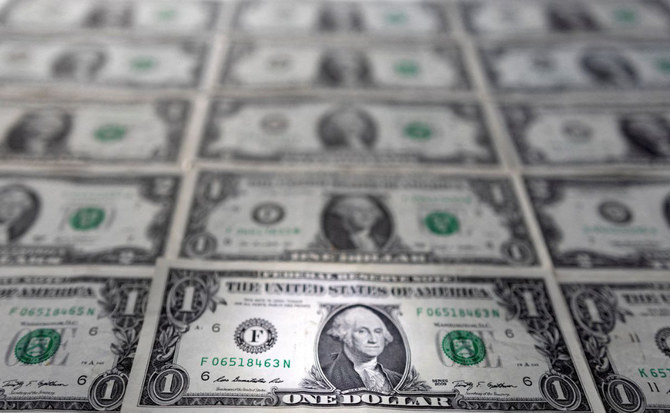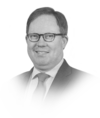The greenback’s rise siphons global investment

https://arab.news/nev5q
The frontline in the global war against inflation runs through the US Federal Reserve headquarters in Washington. After a hesitant start, US monetary policymakers are making up for lost time with policy rates on a runway from near-zero during the pandemic toward nearly 3 percent by the end of the year. Other central banks are following similar upward paths, but look unlikely to match the pace of tightening in the US.
The consequence is a growing interest rate differential that drives the rise of the dollar against other major currencies. The contrast is particularly striking in Japan where a very loose monetary policy stance has driven a sharp depreciation in the yen. But the gap is also widening with the euro.
The European Central Bank is concerned about the repercussions of a military conflict on its eastern flank and risks pertaining to energy trade with Russia, and is toeing a more cautious line than the Fed. Some analysts now speculate that the euro might fall to parity with the dollar this year.
While some of the early leaders on the monetary tightening path, such as the Bank of England, seem to be edging toward a much more cautious stance, the US central bank has so far stuck to its guns. Fed chair Jay Powell earlier this month openly acknowledged that taming inflation to the Fed’s 2 percent target — from its March peak of 8.5 percent, which declined only marginally to 8.3 percent in April — will cause “some pain.”
Perhaps all the more since many of the drivers of inflation are not caused by demand conditions that monetary policy can be expected to address. The dollar is also being bolstered by its traditional safe-haven status at an exceptional time, with risks ranging from the war in Eastern Europe to China’s COVID-19 pandemic lockdowns. All these factors have helped propel the dollar to a two-decade high against a basket of major currencies.
The dynamics of the dollar matter a great deal for the Gulf countries, which all peg their currencies to the greenback. The Kuwaiti dinar is the sole — partial — exception since it follows a heavily dollar-dominated basket. The dollar pegs in practice mean that Gulf central banks have to mirror the interest rate decisions of the Fed. This has been the case consistently this year, again with the partial exception of Kuwait where the added flexibility of its basket allowed the central bank to raise rates by a quarter of a percentage point in response to the half-percent hike by the Fed.
While recurrent periods of divergence between the economic conditions of Gulf Cooperation Council nations and the US have periodically fueled debates about the need for increased exchange rate flexibility, this now increasingly looks like a period when the dollar peg will serve Gulf countries quite well. At a time of global economic volatility, the value of a credible peg is even greater than otherwise.
Moreover, following their exemplary management of the pandemic, GCC economies are experiencing a robust recovery. This pick-up in growth shows every sign of developing further momentum because of a combination of factors. The OPEC+ policy of gradually increasing crude output will mean strong expansion in the oil sector, all the more since a lion’s share of the world’s spare capacity is in the GCC.
By contrast, many other OPEC+ members have struggled to meet their quota increases. The disruptions created by the Ukraine war and tightening sanctions on Russia, amplified by many buyers deliberately boycotting Russian oil, have pushed oil prices to multiyear highs.
While concerns about Chinese demand and the prospect of slower global growth, not to mention a strong dollar, may potentially curb the upside. Nonetheless, for instance, the April Brent crude average of just under $105 was up a hefty 61.4 percent over the same period last year. The Gulf economies now project substantial external and fiscal surpluses.
The non-oil growth outlook remains strong as economic activity and international travel normalize. Growth is further benefiting from major events such as Expo 2020 in Dubai. All these factors have the makings of an exceptionally robust economic rebound with the ability to fuel inflation in consumer and asset prices alike. Countering these upward pressures by matching the US rate hikes is logical and can help the region achieve a more sustainable recovery than might be the case otherwise.
But a strong dollar complicates the global economic outlook in other ways. By pushing up the valuation of US assets at a time when rates are also increasing, they allow investors to achieve acceptable returns by taking on less risk. This curbs the appeal of high-yield securities as well as emerging economies. After a period of rapid growth in emerging market debt during a long period of low interest rates, new pressure points are emerging.
Improving macroeconomic conditions across the Gulf are helping its local economies to withstand such risks. But the relative return calculus also underscores the continued importance of regulatory reform, designed to develop financial markets and attract investment to the Gulf. In an environment where many investors will return to the comfort zone of US assets, safeguarding and further enhancing the appeal of the Gulf through proactive steps will matter that much more. But such steps hold value not just in the short term, but also for the broader economic paradigm shift of more open markets that the region is pursuing. Investor appeal that is built on more than just the oil cycle or exchange rate dynamics is what long-term prosperity can be built on.
A strong dollar is part of why you’re seeing very limited investment in emerging markets today. Why is this here?
• Jarmo Kotilaine is an economist and strategist focusing on the Gulf region. He writes on issues ranging from economic development to changes within the corporate sector.










































